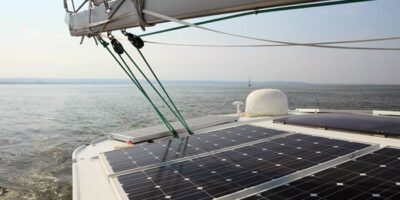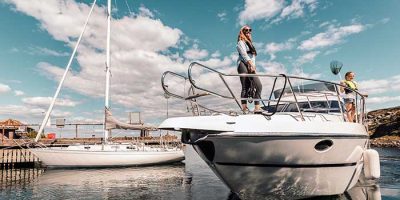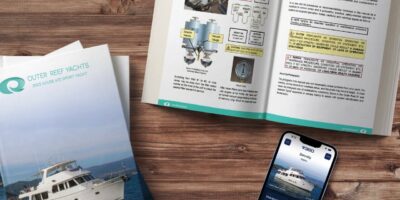How To Prevent Outdrive Corrosion
Here are the obvious and the not-so-obvious mistakes that can cause such severe damage, and how to avoid them.
- January 25, 2024
The damage to the outdrive in the picture is severe, likely starting with a few bubbles in the paint, the first telltale sign that something was wrong. Corrosion, especially on aluminum, changes the surface of the metal so that coatings no longer adhere. As with most marine-related corrosion, regular inspections can head off major problems. Examine your outdrive frequently, and if you find bubbling, peeling paint, or pitting, don’t ignore it. Take steps to correct the problem before your outdrive crumbles. (Corrosion isn’t covered by insurance.) Now let’s look deeper:
Anodes
Aside from bubbling paint, the first thing to check are the anodes — commonly called zincs even when made of other materials — which are critical to preventing corrosion in underwater metals, and your most important line of defense. You don’t need to know the chemistry that causes corrosion, but a simple explanation can help understand and avoid it. When two different kinds of metal are in contact with each other (say, an aluminum outdrive and a stainless-steel propeller) and immersed in saltwater (and to a lesser extent, fresh water), a weak battery is formed between the two. The more “noble” metal (the one more resistant to oxidation and corrosion), in this case stainless steel, tends to remove small amounts of the aluminum from the outdrive as the current flows in the “battery.” An anode, which is a metal that is less noble than either the drive or the prop, can be attached to the aluminum outdrive. The anode will lose out on the battery circuit, thereby protecting the aluminum. But in order to work properly, the anode has to be the right kind, of good quality, and installed correctly.
Anodes are made of three kinds of metals and each has a specific use. Zinc is used in saltwater only, aluminum is used in salt or fresh water, and magnesium is only used in fresh water. Zinc won’t be effective in fresh water, and magnesium won’t be effective in saltwater. If that sounds confusing, don’t worry; in the end, aluminum anodes are effective in the vast majority of both, and even in brackish water. (Aluminum anodes are a different alloy, which is why they can protect aluminum outdrives.)
The best anodes are made to military specifications and some will have “mil-spec” stamped on them. If they don’t, make sure you buy only the best-quality anodes from a reputable marine chandlery like West Marine. Cheap anodes are more likely to contain impurities that will render them far less effective. Even the best anodes must have good contact with the metal they’re protecting, or they will be ineffective. That means they can’t be installed over painted or dirty surfaces. A quick once-over with some fine sandpaper on the metal helps maintain contact. Once installed, anodes should never be painted because this will deactivate them. Finally, anodes have to be replaced when they’re about half gone, because with less surface area, their effectiveness is reduced.
Most anodes are passive, meaning they simply sacrifice themselves as needed, but others, called impressed-current anodes, are active, relying on 12-volt battery power and a controller to force a small amount of DC current through a permanent anode. Impressed current anodes are commonly used on aluminum outdrives in addition to sacrificial anodes, when the sacrificial anodes by themselves would not provide sufficient protection. Impressed current systems, like passive anodes, need to be inspected regularly. They commonly fail due to poor or corroded electrical connections. Many don’t have indicators to show they’re working properly, so most manufacturers recommend testing yearly by a qualified shop.
Shore Power
You might not think that a boat’s power connection could have anything to do with a corroding outdrive, but it can. Aside from missing anodes, it’s probably the most common cause of severe corrosion. Boats plugged into shore power share the green ground wire with every other plugged-in boat in the marina. The ground wire is critical to a safe boat because it carries off dangerous current from a fault in the shore power system. But because the shore power ground wire is also connected to the DC ground system (which is critical to preventing shocks to swimmers in the area), it extends to a boat’s bonded underwater metals — including the outdrive.
The outdrive is then connected to the neighbor’s grounded underwater metals (even one several boats away), which may be stainless steel or bronze. Because the two different metals are in the water and connected through the ground wire, it’s the same as if they were in direct contact. If a boat’s underwater metal isn’t protected by an anode, it will use a neighboring boat’s anode for protection. When that’s gone, it will use other less-noble metals, likely an outdrive, to protect itself. The solution is to install a galvanic isolator, which will prevent low-level DC current from flowing through the green wire — effectively breaking the connection to neighboring boats — but still allowing shore power current to flow to ground in an emergency.
Stray Current
Another way an outdrive can be destroyed by corrosion is through a voltage leak in a DC system. This problem is less common and typically caused by a fault in a boat’s 12-volt DC system. For example, if a bilge pump sitting in saltwater were to have a break in the DC wire’s insulation, current could destroy metal fittings in the bilge.
Avoiding stray current corrosion means making sure that there are no wires in the bilge (all wires should be supported above the level of expected bilge water), except the wire to the bilge pump. The latter should be inspected to make sure it’s in good shape. Aside from keeping wires out of the bilge, the most effective way to prevent stray-current corrosion is to have all of your underwater metal bonded to the boat’s ground. That way, any leaks will be brought back to your battery before they have a chance to destroy fittings. Most new boats are bonded from the factory, but older boats can be retrofitted. It should be noted that a galvanic isolator won’t normally prevent stray current corrosion damage because the damaging voltage exceeds what the isolator can stop.
AC Corrosion
Some informal research spearheaded by our BoatUS Technical Services department showns that AC current may cause corrosion, at least in aluminum, though normally at slower rates than DC current. AC leakages need to be significantly higher than DC to cause corrosion, because AC switches from positive to negative 60 times per second.
On the positive cycle, corrosion occurs, but on the negative cycle, some re-plating occurs so corrosion can take significantly longer. However, it’s believed that in swiftly moving water, as in a marina with current, the re-plating may not always occur, and AC corrosion will be accelerated.
Studies have shown that in most metals, such as iron and copper, AC current has about one percent of the effect of DC current as it relates to corrosion, but AC current has about 40 percent of the effect that DC has on aluminum. While this may be important in determining how a corrosion incident occurred, it pales in comparison to what leaking AC current can do to swimmers in the water. Even very small amounts of AC current can disable a swimmer’s muscles and cause drowning. New boats are equipped with a device called an equipment-leakage circuit interrupter (ELCI) that prevents shocks to swimmers in the water in the event of a fault, and also offers some protection against AC current corrosion.
Charles Fort
Contributing Editor, BoatUS Magazine
About Vessel Vanguard
Vessel Vanguard is a leading marine safety and maintenance management software provider dedicated to revolutionizing the maritime industry. With a commitment to innovation and excellence, Vessel Vanguard delivers cutting-edge solutions to streamline operations and enhance vessel performance and safety.
Latest Industry Insights

Embracing E-Boating Efficiencies

Boat Fuel Systems

The Future of Boats & Boating

Yacht Navigation Light Inspection
View All of Our Industry Insights
Navigate maritime with the latest news, practical how-to guides, insightful analyses and more.
